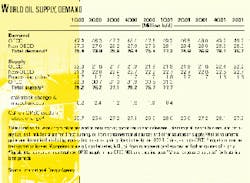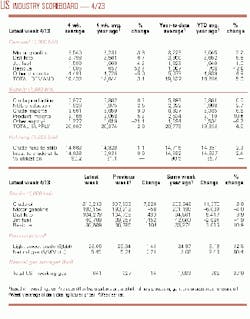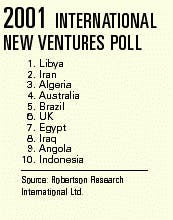OGJ Newsletter
Market Movement
IEA lowers global oil demand forecast
How far can sagging economies drag down growth in oil demand? IEA again has lowered its estimate of global oil demand growth, for the fifth month running.
In its April oil market report, IEA lowers its estimate of worldwide oil demand for 2001 to 76.7 million b/d, a cut of 85,000 b/d from its estimate a month earlier. This will put 2001 growth in oil demand at 1.325 million b/d compared with a jump of 580,000 b/d last year.
IEA has reduced its assessment of this year's demand due partly to weaker than expected January deliveries in some countries. Also cited as a reason is the appearance that the slowdown in the US economy will be more protracted than originally expected. Coupled with relatively high oil prices, this will lead to a reduction in oil demand growth in countries whose economies are most dependent on US markets, especially those with ties to the communications and computer industries.
Oil demand growth
In spite of slowing of the economy in the US, oil products demand in North America has remained surprisingly buoyant, says IEA, because of factors such as high natural gas prices and delivery concerns, encouraging fuel-switching from gas to residual fuel and heating oil in light of unusually strong demand for power generation.
North American oil de- mand actually grew 5.5% in January and 3.2% in February, and signs indicate that March demand growth in the US was also strong. Based on these data, IEA this month has raised its estimate of 2001 North American demand growth by 30,000 b/d to 360,000 b/d, a 1.5% increase from 2000. This assumes that the US economy will rebound in the second half, with a U-shaped recovery. Otherwise, oil demand growth will not be as robust.
IEA has slightly trimmed its estimate of demand growth in the OECD Pacific countries following signs indicating that first quarter deliveries were a bit more sluggish than earlier expected. Year 2001 demand growth in this region is projected to be 1.6% compared with last year (see table).
New estimates show that slower growth has been forecast for Europe also. Growth in oil demand in Europe this year is now pegged at 1.1% vs. 1.2% in last month's report from IEA. Several reasons are cited for this revision, among them high precipitation volumes this winter and spring ensure that there will be adequate hydropower. Also, the report says, there has been "a deliberate shift by state utilities away from residual fuel oil toward natural gas and NGL for power generation."
In the former Soviet Union, where exports are favored over domestic consumption, oil demand is expected to drop this year by 1.4%. Natural gas and coal are being promoted for use in power generation in the FSU in order to make more oil available for export.
IEA expects oil demand in China to increase this year, up 4.6% from last year. This is still not as strong as China's 1999 growth in demand for oil of 7.3% or year 2000 growth of 6.6%.
The estimate of demand for oil in the other non-OECD Asian countries such as the Philippines, Taiwan, Thailand, and Malaysia-whose economies are heavily dependent on electronics exports and therefore are tied to the health of the US economy-has been revised downward. IEA now estimates that oil demand in these countries will grow by 1.9% this year vs. 2.3% growth last year.
null
null
null
Industry Trends
LIBYA HAS TAKEN THE TOP SPOT IN the E&P PROSPECT RANKINGS.
Libya scored the highest this year as the most popular country for new exploration, development, and production ventures, with Iran claiming second place.
These are the findings of Robertson Research Inter- national, Llandudno, UK, after its latest annual international new ventures survey, in which the firm polls E&P companies based outside North America (see table).
In the survey, now in its 14th year, Robertson asked companies about their levels of interest in E&P ventures in 146 countries. This year, responses came from 85 companies, which among them are expected to account for 70% of global E&P spending this year.
"The most popular region is the Middle East, followed by Far East-Australasia. Outside the top 10, the most impressive gains in ranking in 2001 [over 2000] are by Mexico, Ecuador, and Morocco, and the biggest falls by Eritrea, Thailand, and Myanmar," said Robertson.
About 51% of the survey respondents are actively seeking new ventures this year, and 56% said that they plan to invest in new projects outside of those in which they are currently involved. Robertson noted that interest in natural gas continues to climb, especially among the majors, and that 34% of survey respondents are expected to increase their deepwater ventures.
US CRUDE AND PRODUCTS IMPROTS SET A RECORD IN THE FIRST QUARTER, API said
It said imports were 11.6 million b/d for the quarter, 12% higher than year-ago levels and equal to 59% of US petroleum deliveries.
More than half of the year-to-year, 1.3 million b/d increase in imports was in the form of crude oil, helping to build those stocks to their highest month-end level since summer 1999. Product imports were also unusually strong.
API said refinery activity slowed seasonally from the fourth quarter's high rates, as many refiners performed maintenance in advance of the summer driving season. Still, refinery inputs for the first quarter topped year-ago levels by more than 3%.
Meanwhile, continued strong growth for distillate fuel oil (which includes highway diesel, home heating oil, and other fuels) helped to push the increase in petroleum deliveries for the first quarter to 2.9%. Deliveries of distillate fuel oil jumped nearly 9% compared with the first quarter of last year.
API said the increase in petroleum deliveries was aided by higher natural gas prices, which have continued to drive industrial and utility users with the capability to switch to residual fuel oil. As a result, resid deliveries for the first quarter jumped 40% compared with a year earlier.
"Gasoline deliveries also showed some very tentative signs of revival from last year's flat performance, though March's increase by itself was not much more than half a percent compared with 1 year earlier," API said.
Government Developments
NORWAY'S OIL INDUSTRY CLAIMS THAT A PROPOSED Tax CHANGE WILL UNDERMINE NEW OFFSHORE FIELD DEVELOPMENT
The deputy director general of the Norwegian Oil Industry Association (OLF) this month called for the country's Minis-try of Finance to rethink proposed changes to the tax re-gime on the Nor- wegian Continental Shelf that he believes will undermine fu- ture field developments in the offshore province.
OLF's Nils Heilemann said the ministry's new proposals, announced Apr. 13, "entail a comprehensive shift in the complex petroleum tax system and a significant tax increase."
Under the new proposals, all oil companies operating on the NCS would be hit by plans to effectively suspend the so-called "uplift," which allows new fields to forego an offshore tax that can be as high as 78%, through the early field development phase.
The ministry also proposes to see fiscal terms split between Norway's 78% offshore tax and the 28% corporate income tax in proportion with nondepreciated asset values, which is likely also to result in a tax rise for oil companies.
Heilemann said the proposal, in contrast to the government's stated policy, will decrease the competitiveness of the NCS and will have a "particularly adverse impact" on new development projects.
"Predictability is diminished, and uneasiness is created surrounding the implementation of key oil policy goals," he stressed.
DEMOCRAT SENATORS ARE ASKING THE US GENERAL ACCOUNTING OFFICE TO INVESTIGATE FERC'S ROLE IN OVERSEEING NATURAL GAS AND POWER PRICES.
Sens. Joe Lieberman (D-Conn.) and Jean Carnahan (D-Mo.) asked GAO to conduct an investigation of FERC's actions to ensure that wholesale electricity prices are reasonable.
They also requested GAO take a look at FERC's role in overseeing interstate natural gas pipelines. The senators said they were troubled because electricity suppliers in California are charging many times more than the cost of producing electricity.
The high electricity prices in that state reflect a nonfunctioning market that has, in turn, exacerbated the state's electricity shortage, according to their letter to the GAO.
Worried about the impact of pending electricity deregulation in the state of Missouri, Sen. Carnahan wants to make sure that there is adequate federal oversight.
"Under federal law, FERC has the responsibility to ensure just and reasonable prices for interstate wholesale transmission, but there is mounting evidence that FERC may not have fulfilled this role in the California situation," according to the letter.
With gas costing about five times the national average in California, the senators also want GAO to look into the possible abuse of market power in the transmission of gas in California.
Quick Takes
SHELL TAKES CENTER STAGE THIS WEEK IN GAS PROCESSING NEWS.
Shell Gas & Power, Royal Dutch/Shell's gas and power arm, said it is rolling out two further studies into the international investment potential of GTL projects using its proprietary middle distillate synthesis (SMDS) process.
The studies, being carried out in Argentina and Australia, follow JV plans with Egyptian General Petroleum Corp. (EGPC) to build a second-generation 75,000 b/d GTL conversion plant with at least one LNG train on the Mediterranean coast, along with studies into potential similar projects in Indonesia, Iran, and Trinidad and Tobago.
In Argentina, Shell is scouting locations for a plant in Tierra del Fuego, where it is in discussion with a local consortium regarding the possible supply of offshore natural gas to the facility. In Australia, the company is exploring sites in both Western Australia and Northern Territory for a GTL plant.
SMDS is a three-stage process used at Shell's 12,000 b/d Bintulu plant in Malaysia that converts natural gas into "ultraclean" naphtha, gas oil, and kerosine.
Meanwhile, Shell India reported that its plans for a 5 million tonne/year LNG terminal and port at Hazira, India, moved ahead this month when the company received Ministry of Environment & Forests clearance for the project. As part of larger plans to forge a global "LNG value chain," Shell placed an order for two LNG carriers with Japan's Mitsubishi Heavy Industries last year. Keel laying for the first of these 135,000 cu m tankers is scheduled for June, with sea trials in September 2002.
In other gas processing action, BG advanced plans for an integrated LNG export project in Egypt with the signing of a commercial agreement with EGPC and Edison International. The project will involve development of discovered, uncontracted gas reserves in the West Delta Deep Marine concession off Egypt in the Nile Delta-home to the deepwater Scarab-Saffron fields-along with the construction of a $900 million onshore liquefaction plant at Idku on the Mediterranean coast. BG said the deal also covers proposed amendments to the existing WDDM concession agreement, which will be subject to ratification by the Egyptian government, and sets the commercial framework for the LNG export development. Scarab and Saffron fields are being developed for the domestic market. The associated Simian, Sapphire, Sienna, and Serpent discoveries would support the LNG project. First gas from Scarab-Saffron, the largest gas field development in Egypt, is scheduled for January 2003, said BG. Plans are for the LNG liquefaction plant to be located at Idku, near Alexandria, adjacent to the Rosetta and Scarab-Saffron gas processing terminals.
Syntroleum said it awarded a $215.4 million operating and maintenance contract to a JV of PGS Production Services and Clough Engineering for the 10,000 b/d Sweetwater GTL plant in western Australia. PGS and Clough are to provide complete operating services for the GTL plant on the Burrup Peninsula. The plant will convert natural gas into ultraclean and sulfur-free synthetic specialty products, such as lubricants, industrial fluids, and paraffins, as well as synthetic transportation fuels (OGJ Online, Feb. 23, 2001). Construction is slated to begin later this year.
THAI SHELL E&P HAS BOSTED ITS PETROLEUM RESERVES AT SIRIKIT FIELD.
Thai Shell E&P has increased its estimated petroleum reserves through secondary recovery techniques and exploration success.
Thai Shell increased reserves in Greater Sirikit field-in the northern province of Kamphaeng Phet-as of Dec. 31 by 8.8% to 148 million bbl of oil and boosted natural gas reserves by 1.2% to 250 bcf.
In production since 1982, Sirikit and its sister fields had produced 128.1 million bbl of oil and 276 bcf of gas by Dec. 31.
Thai Shell said a successful waterflood at Greater Sirikit field would extend its current production plateau of 24,000 b/d of oil and 60 MMcfd of gas for 10-12 years.
In other production news, Kyle field in the UK North Sea began production Apr. 7 through two wells, the field's single largest stakeholder, Premier Oil, said. Output from the Ranger Oil UK-operated development, on Block 29/2c in the central North Sea, is expected to stabilize at around 20,000 b/d of oil. The oil is being processed along with that of nearby Curlew field via the Maersk Curlew FPSO stationed 18 km south of Kyle. Gas is exported through the SEGAL pipeline system. Premier said a third production well is to be drilled later this year. Last year, 1.5 million bbl was produced during an extended well test at Kyle.
PETROBRAS ADMITTED THAT THE AMOUNT OF OIL SPILLED FROM THE P-7 PRODUCTION PLATFORM IN BICUDO FIELD OFF BRAZIL WAS NEARLY DOUBLE ITS ORIGINAL ESTIMATE.
In an announcement made with Brazilian environmental authority Ibama, and Feema, the Rio de Janeiro state environmental body, Petrobras said some 25,000 l. of oil, not 13,000 l. as first reported, had leaked from the platform.
The oil company said two vessels specialized in environmental clean-up operations were working to contain the spill, which occurred Apr. 12.
According to Petrobras, the two containment barges are equipped with 300-m containment booms, equipment to recover the spilled oil, and capacity to store over 2 million l.
The P-7, operating in water depths of 210 m, was producing 15,000 b/d from the Bicudo 12 well.
STATOIL COMMANDS THE SPOTLIGHT THIS WEEK IN PIPELINE NEWS.
Statoil has given Norway's Minister of Petroleum and Energy a proposal to boost capacity in the natural gas pipeline planned for its North Sea Kvitebj rn field, the Norwegian state-owned company said.
The scheme, a supplement to the company's recently submitted plan for installation and operation (PIO) of the line, suggests "more capacity can be achieved without additional cost" by streamlining the pipeline's landfall route to accommodate output from other fields.
The proposal for the line cuts the cost of its landfall layout by almost 50% from the PIO figure, to around 200 million kroner ($21.8 million). Statoil's revised plans would have the pipeline, which will run to its Kollsnes gas treatment plant near Bergen, carry production from fields near Kvitebj rn and Troll, on top of the gas already handled from the latter development. Kvitebj rn holds 52 billion cu m of gas. The field will begin deliveries under existing sales contracts by October 2004.
Meanwhile, Statoil shut down the Zeepipe trunkline last week following a leak on an unmanned riser platform tied back to its Sleipner A installation in the Norwegian Sea.
Statoil said it would take about 2 weeks to repair the pipeline, which transports gas from numerous fields off Norway to Zeebrugge in Belgium.
Until gas transport resumes, European customers for Zeepipe gas will be supplied from alternative landfalls in Germany and France. Around 20% of the 56.8 billion cu m/year exported from Norway flows via the 814-km Zeepipe.
In other pipeline happenings, a Williams unit is preparing to apply for one of its largest US mainland expansion projects after securing 526 MMcfd of binding commitments. The Momentum expansion project will enlarge the Transcontinental Gas Pipeline system from Station 65 near Greensburg, La., to Station 165 near Chatham, Va., to meet increasing natural gas demand in the southeastern US. Williams said the project would require pipeline looping along the existing mainline as well as additional horsepower at existing compressor stations. It is expected to be in service by May 1, 2003.
Tuscarora Gas Transmission applied to FERC for a $60 million pipeline expansion to meet the growing needs of natural gas customers in northern Nevada. Tuscarora, a Nevada general partnership, is a pipeline subsidiary of Sierra Pacific Resources and TC PipeLines. The Tuscarora pipeline was constructed in 1995 by a partnership of Sierra Pacific Resources and TransCanada PipeLines. The 229-mile pipeline stretches from Malin, Ore., through northern California to Sierra Pacific Power's Tracy power station near Reno, Nev. The proposed expansion consists of three compressor stations and a 14-mile pipeline extension from the Tracy power plant near Reno to Wadsworth, Nev., and would include an interconnect with the Paiute Pipeline. If constructed, capacity on Tuscarora's pipeline system would increase to 220 MMcfd from 125 MMcfd. Subject to regulatory approval, Tuscarora plans to begin construction in April 2002, with completion slated for late 2002.
A FIRE AT CONOCO'S HUMBER REFINERY CAUSED MINOR DAMAGES TO THE PLANT'S MAIN UNITS.
Investigators began sifting through the damage to determine what caused the Apr. 16 explosion and fire at Conoco's 230,000 b/d Humber refinery in northern England.
Early cursory examination indicated relatively little damage to the plant's crude processing, gasoline refining, and coking units, said Conoco.
Most of the fire damage apparently was limited to the small saturate gas unit where the initial explosion is thought to have occurred, said the company. Conoco also reported collateral damage to a heater on the adjacent No. 2 coker at the plant. The refinery is on a 480-acre site on the Humber River in northern Lincolnshire and is the world's largest producer of needle coke.
The refinery will remain shut for 3 weeks as company and government investigators determine what caused the accident.
MMS HAS ISSUED PROPOSED NOTICES OF SALE FOR WESTERN GULF OF MEXICO LEASE SALE 180 AND CENTRAL GULF OF MEXICO SALE 178, PART 2
Both offer blocks in the Western Gap, formerly in dispute with Mexico. In Sale 178, Part 2, MMS will offer 53 blocks not offered in Central Gulf Sale 178, Part 1, which was held Mar. 28.
The blocks are beyond the US Exclusive Economic Zone in the northern portion of the area known as the Western Gap.
In Sale 180, MMS will offer 4,106 unleased blocks, covering about 22.39 million acres, in the Western Gulf of Mexico Outer Continental Shelf planning area off Texas and in deeper waters off Louisiana. The sale will include 258 blocks in the Western Gap.
Elsewhere on the exploration front, Santos, operator for the South West Queensland Unit, announced a gas discovery in the Queensland sector of the Cooper basin, 138 km southwest of the Ballera gas plant. The Quasar South 1 flowed 6.1 MMcfd from Permian Patchawarra. The well will be connected via the Chiron pipeline to the Cooper basin gas-gathering network and brought on stream when a production license is awarded in a few months.
Sinopec Star Petroleum, a subsidiary of China Petrochemical, has a gas discovery in the East China Sea. Tianwaitian-3 flowed 683,000 cu m/day of gas and 28 cu m/day of condensate late last month. The well is 400 km southeast of Shanghai. It is part of the Xihu Sag, where Sinopec Star and China National Offshore Oil are conducting joint exploration and development. The well was drilled to 3,760 m MD and found more than 10 gas pay zones.
Meridian Resource has a new field discovery with the Hughes No. 1 in Jefferson Davis Parish, La. The hole was drilled to 19,079 ft, and logs indicate 240 gross ft of pay in deep Bol mex sands. Meridian will test the well in 30-45 days.
This special analysis of the IEA's Oil Market Report and its effects on the international oil market was provided by Marilyn Radler, Economics Editor.







